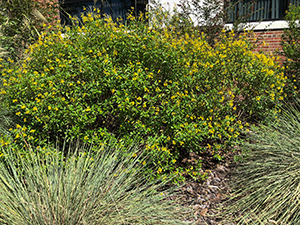Thryallis

Thryallis is a Florida-Friendly splash of color that we love to see in landscapes. If you’re looking for a low-maintenance, reliable shrub with a stunning floral display, this is the plant for you.
Characteristics
Also commonly known as “rain-of-gold,” Galphimia gracilis is a flowering, evergreen shrub. Although native to Mexico and Central America, thryallis is well-adapted to Florida’s climate and not considered invasive. It thrives in Central and South Florida, USDA Hardiness Zones 9-11. Further north than zone 9 it may experience freeze damage and some die back. Still, with proper cold protection thryallis will grow back from the roots year after year, even in North Florida.
In areas without yearly freezes, thryallis reaches a mature size of 4-6 feet wide and 5-9 feet high. Some gardeners allow it to maintain its mounding shape. It can also be trained into a small, multi-trunked tree or pruned into a loose hedge. Thryallis looks particularly charming in a mixed-perennial display, combined with other flowering shrubs.
Thryallis’ foliage is a cheery green, and remains evergreen in areas without a winter freeze. The stems of new growth are red and contrast beautifully during the beginning of the spring growing season. At the end of new shoots, eye-catching yellow flower clusters wave in the breeze. Generally thryallis blooms during summer and fall, but in the warmer areas of the state you may enjoy the flowers year-round. After the flowers fade, persistent, berry-like fruits continue to add texture through the fall and winter.
Planting and Care
Thryallis looks its best planted in full sun. It will tolerate some shade but may flower less and become leggy. Do not plant thyrallis in a high-traffic area; its branches can be brittle and break easily. Well-drained soil of any texture will support thryallis, but it does not tolerate salt water or spray.

Thryallis’ airy, mounding form needs no pruning. However, if you prefer a more regular shape, prune in the spring. This will reduce the number of flower clusters that year, but not in the long-term.
Propagate this shrub by seed and summer cuttings or purchase a young plant from a nursery. Once established, thryallis is moderately drought tolerant. It also suffers from very few pests and diseases, making this plant a low-maintenance addition to your garden. Finally, for gardeners hoping to deer-proof their landscape, thryallis is not a preferred food of these voracious visitors.
